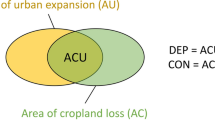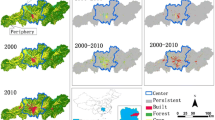Abstract
Cropland expansion to meet the growing demand for food and fuel is a driving factor in forest degradation. Over the next few decades, increases in the area of agricultural land are expected to be concentrated in sub-Saharan Africa, which still has large tracts of unexploited land suitable for agricultural production. We analyzed land-cover change in northern Ghana between 1984 and 2015 and compared it with background social factors associated with land change. Maps from three points in time were analyzed to identify the impact of cropland expansion on the distribution of natural vegetation. Three-level intensity analysis revealed that the overall rate of change for the 31-year period was less than that of the first time interval (1984–1999); however, the overall impact on natural vegetation was substantial, and grassland in particular was reduced to a very small proportion of the area over the period. Cropland replaced only grassland during the first time interval, but also began to replace open woodland during the second interval (1999–2015). The in-depth assessment revealed that cropland expansion continued at a steady rate, but the impact on natural vegetation was not uniform across vegetation types; grassland was more vulnerable than woodland, and woodland became increasingly targeted with continual expansion of the agricultural frontier as population increased. Further validation of the socio-cultural factors associated with the observed transitions will help to identify the explicit implications and assist in developing strategies to minimize the impacts of land-use change on regional livelihoods.






Similar content being viewed by others
References
Akinyemi FO, Gilmore R Jr P, Braimoh AK (2016) Land change dynamics: insights from Intensity Analysis applied to an African emerging city. J Spat Sci 8596:0–15. https://doi.org/10.1080/14498596.2016.1196624
Aldwaik SZ, Pontius RG (2012) Intensity analysis to unify measurements of size and stationarity of land changes by interval, category, and transition. Landsc Urban Plan 106:103–114. https://doi.org/10.1016/j.landurbplan.2012.02.010
Aldwaik SZ, Pontius RG (2013) Map errors that could account for deviations from a uniform intensity of land change. Int J Geogr Inf Sci 27:1717–1739. https://doi.org/10.1080/13658816.2013.787618
Alo CA, Pontius RG (2008) Identifying systematic land-cover transitions using remote sensing and GIS: the fate of forests inside and outside protected areas of Southwestern Ghana. Environ Plan B Plan Des 35:280–295. https://doi.org/10.1068/b32091
Antwi EK, Boakye-danquah J, Asabere SB (2014) Paper: land use and landscape structural changes in the ecoregions of Ghana. J Disaster Res 9:462–467
Avtar R, Takeuchi W, Sawada H (2011) Full polarimetric PALSARbased land cover monitoring in Cambodia for implementation of REDD policies. Int J Digit Earth. https://doi.org/10.1080/17538947.2011.620639
Avtar R, Herath S, Saito O, Gera W, Singh G, Mishra B, Takeuchi K (2013) Application of remote sensing techniques toward the role of traditional water bodies with respect to vegetation conditions. Environ Dev Sustain. https://doi.org/10.1007/s10668-013-9507-4.
Boafo YA, Saito O, Takeuchi K (2014) Provisioning ecosystem services in rural Savanna landscapes of Northern Ghana: an assessment of supply, utilization, and drivers of change. J Disaster Res 9:501–515
Boafo YA, Saito O, Jasaw GS et al. (2016) Provisioning ecosystem services-sharing as a coping and adaptation strategy among rural communities in Ghana’s semi-arid ecosystem. Ecosyst Serv 19:92–102. https://doi.org/10.1016/j.ecoser.2016.05.002
Boakye-Danquah J, Antwi EK, Saito O et al. (2014) Impact of farm management practices and agricultural land use on soil organic carbon storage potential in the Savannah Ecological zone of Northern Ghana. J Disaster Res 9:484–500
Bosu D (2013) Draft report on the dynamics of harvesting and trade in rosewood (Pterocarpus erinaceous) in Bole, Central, West and North Gonja Districts of the Northern Region http://www.ecosystemalliance.org/sites/default/files/documents/Dynamics%20of%20Rosewood%20Trade%20in%20Northern%20Ghana.pdf
Braimoh AK (2004) Seasonal migration and land-use change in Ghana. Land Degrad Dev 15:37–47. https://doi.org/10.1002/ldr.588
Braimoh AK (2006) Random and systematic land-cover transitions in northern Ghana. Agric Ecosyst Environ 113:254–263. https://doi.org/10.1016/j.agee.2005.10.019
Braimoh AK (2009) Agricultural land-use change during economic reforms in Ghana. Land Use Policy 26:763–771. https://doi.org/10.1016/j.landusepol.2008.10.006
Braimoh AK, Vlek PLG (2005) Land-cover change trajectories in northern Ghana. Environ Manag 36:356–373. https://doi.org/10.1007/s00267-004-0283-7
Byerlee D, Stevenson J, Villoria N (2014) Does intensification slow crop land expansion or encourage deforestation? Glob Food Sec 3:92–98. https://doi.org/10.1016/j.gfs.2014.04.001
Deininger K, Byerlee D, Lindsay J, Norton A, Selod H, and Stickler M (2011) Rising Global Interest inFarmland - can it yield sustainable and equitable benefits? The World Bank. p 164. https://siteresources.worldbank.org/DEC/Resources/Rising-Global-Interest-in-Farmland.pdf
Díaz S, Demissew S, Carabias J, Joly C, Lonsdale M, Ash N, Larigauderie A, Adhikari JR, Arico S, Bàldi A, Bartuska A, Baste IA, Bilgin A, Brondizio E, Chan KM, Figueroa VE, Duraiappah A, Fischer M, Hill R, Koetz T, Leadley P, Lyver P, Mace GM, Martin-Lopez B, Okumura M, Pacheco D, Pascual U, Pѐrez ES, Reyers B, Roth E, Saito O, Scholes RJ, Sharma N, Tallis H, Thaman R, Watson R, Yahara T, Hamid ZA, Akosim C, Al-Hafedh Y, Allahverdiyev R, Amankwah E, Asah TS, Asfaw Z, Bartus G, Brooks AL, Caillaux J, Dalle G, Darnaedi D, Driver A, Erpul G, Escobar-Eyzaguirre P, Failler P, AMM Fouda, Fu B, Gundimeda H, Hashimoto S, Homer F, Lavorel S, Lichtenstein G, Mala WA, Mandivenyi W, Matczak P, Mbizvo C, Mehrdadi M, Metzger JP, Mikissa JB, Moller H, Mooney HA, Mumby P, Nagendra H, Nesshover C, Oteng-Yeboah AA, Pataki G, Rouѐ M, Rubis J, Schultz M, Smith P, Sumaila R, Takeuchi K, Thomas S, Verma M, Yeo-Chang Y, Zlatanova D (2015) The IPBES Conceptual Framework — connecting nature and people. Curr Opin Environ Sustain 14:1–16. https://doi.org/10.1016/j.cosust.2014.11.002
Enaruvbe GO, Pontius RG (2015) Influence of classification errors on Intensity Analysis of land changes in southern Nigeria. Int J Remote Sens 36:244–261. https://doi.org/10.1080/01431161.2014.994721
Ghana Statistical Service (GSS) (2012). Population and housing census - post enumeration survey report. Ghana Statistical Service, Accra: Republic of Ghana
Gyasi, EA (1995). Farming in Northern Ghana. ILEIA Newsletter 11:23
Jasaw GS, Saito O, Takeuchi K (2015) Shea (Vitellaria paradoxa) butter production and resource use by urban and rural processors in northern Ghana. Sustainability 7:3592–3614. https://doi.org/10.3390/su7043592
Kranjac-Berisavljevic’ G, Bayorbor TB, Obeng TB (2002) Soil and water conservation in Ghana – review. In: Slaymaker T, Blench R (eds) Rethinking natural resource degradation in sub-Saharan Africa – joint ODI-UDS publication on policies to support sustainable soil fertility management, and soil and water conservation among the resource poor farmers in semi arid areas, chapter (II), vol I. Ghana: Cyber Systems, p 50. ISBN 9988-611-05-6
Kranjac-Berisavljevic G (2015). Transformations of traditional landuse systems and their effects on development opportunities and people’s livelihoods in Northern Ghana. ICDD working papers 14. Kassel University Press, Germany
Laurance WF, Sayer J, Cassman KG (2014) Agricultural expansion and its impacts on tropical nature. Trends Ecol Evol 29:107–116. https://doi.org/10.1016/j.tree.2013.12.001
Manandhar R, Odeh IOA, Pontius RG (2010) Analysis of twenty years of categorical land transitions in the Lower Hunter of New South Wales, Australia. Agric Ecosyst Environ 135:336–346. https://doi.org/10.1016/j.agee.2009.10.016
Nagendra H, Munroe DK, Southworth J (2004) From pattern to process: landscape fragmentation and the analysis of land use/land cover change. Agric Ecosyst Environ 101:111–115. https://doi.org/10.1016/j.agee.2003.09.003
Olofsson P, Foody GM, Herold M et al. (2014) Good practices for estimating area and assessing accuracy of land change. Remote Sens Environ 148:42–57. https://doi.org/10.1016/j.rse.2014.02.015
Oppong-Anane K (2006) Country pasture/forage resource profiles, Ghana. FAO, Rome
Otsuki K, Jasaw GS, Lolig V (2014) Framing community resilience through mobility and gender. J Disaster Res 9:554–562
Phalan B, Onial M, Balmford A, Green RE (2011) Reconciling food production and biodiversity conservation: land sharing and land sparing compared Science 333:1289–1291. https://doi.org/10.1126/science.1208742
Pontius RG, Shusas E, McEachern M (2004) Detecting important categorical land changes while accounting for persistence. Agric Ecosyst Environ 101:251–268. https://doi.org/10.1016/j.agee.2003.09.008
Romero-Ruiz MH, Flantua SGA, Tansey K, Berrio JC (2012) Landscape transformations in savannas of northern South America: land use/cover changes since 1987 in the Llanos Orientales of Colombia. Appl Geogr 32:766–776. https://doi.org/10.1016/j.apgeog.2011.08.010
Shoyama K, Braimoh AK (2011) Analyzing about sixty years of land-cover change and associated landscape fragmentation in Shiretoko Peninsula, Northern Japan. Landsc Urban Plan 101:22–29
Teixeira Z, Marques JC, Pontius RG (2016) Evidence for deviations from uniform changes in a Portuguese watershed illustrated by CORINE maps: an Intensity Analysis approach. Ecol Indic 66:382–390. https://doi.org/10.1016/j.ecolind.2016.01.018
Turner BL, Lambin EF, Reenberg A (2007) The emergence of land change science for global environmental change and sustainability. Proc Natl Acad Sci USA 104:20666–71. https://doi.org/10.1073/pnas.0704119104
Versace VL, Ierodiaconou D, Stagnitti F, Hamilton AJ (2008) Appraisal of random and systematic land cover transitions for regional water balance and revegetation strategies. Agric Ecosyst Environ 123:328–336. https://doi.org/10.1016/j.agee.2007.07.012
Villamor GB, Pontius RG, van Noordwijk M (2014) Agroforest’s growing role in reducing carbon losses from Jambi (Sumatra), Indonesia. Reg Environ Change 14:825–834. https://doi.org/10.1007/s10113-013-0525-4
Zhou P, Huang J, Pontius RG, Hong H (2014) Land classification and change intensity analysis in a coastal watershed of Southeast China. Sensors (Basel) 14:11640–11658. https://doi.org/10.3390/s140711640
Acknowledgements
This study was supported by “Enhancing Resilience for Climate and Ecosystem Change: An Integrated Approach in Semi-Arid Africa (CECAR-Africa)” funded by the Japan International Cooperation Agency and the Japan Science and Technology Agency.
Author information
Authors and Affiliations
Corresponding author
Ethics declarations
Conflict of Interest
The authors declare that they have no conflict of interest.
Appendix I Confusion Matrix of 2015 Landsat Classification
Appendix I Confusion Matrix of 2015 Landsat Classification
Closed woodland | Open woodland | Grassland | Cropland | Built-up | Water | Total | Producer’s accuracy (%) | |
|---|---|---|---|---|---|---|---|---|
Closed woodland | 26 | 3 | 0 | 1 | 0 | 0 | 30 | 87 |
Open woodland | 4 | 41 | 2 | 3 | 0 | 0 | 50 | 82 |
Grassland | 1 | 2 | 24 | 5 | 1 | 0 | 33 | 73 |
Cropland | 1 | 1 | 4 | 46 | 2 | 1 | 55 | 84 |
Built-up | 0 | 0 | 0 | 1 | 19 | 0 | 20 | 95 |
Water | 0 | 0 | 0 | 0 | 0 | 21 | 21 | 100 |
Total | 32 | 47 | 30 | 56 | 22 | 22 | 209 | – |
User’s accuracy (%) | 81 | 87 | 80 | 82 | 86 | 95 | – | 85 |
Rights and permissions
About this article
Cite this article
Shoyama, K., Braimoh, A.K., Avtar, R. et al. Land Transition and Intensity Analysis of Cropland Expansion in Northern Ghana. Environmental Management 62, 892–905 (2018). https://doi.org/10.1007/s00267-018-1085-7
Received:
Accepted:
Published:
Issue Date:
DOI: https://doi.org/10.1007/s00267-018-1085-7




